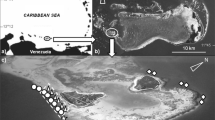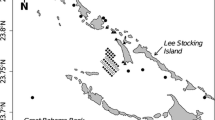Abstract
The invasion by Indo-Pacific lionfish (Pterois volitans and P. miles) of the western Atlantic, Caribbean and Gulf of Mexico is emerging as a major threat to coral reef communities across the region. Comparing native and introduced populations of invasive species can reveal shifts in ecology and behaviour that can accompany successful invasions. Using standardized field surveys replicated at multiple sites in Kenya and the Bahamas, we present the first direct comparisons of lionfish density, body size, biomass and behaviour between native and invaded coral reefs. We found that lionfish occur at higher densities with larger body sizes and total biomass on invaded Bahamian coral reefs than the ecologically equivalent species (P. miles) does on native Kenyan reefs. However, the combined average density of the five lionfish species (Pterois miles, P. antennata, P. radiata, Dendrochirus brachypterus and D. zebra) on Kenyan reefs was similar to the density of invasive lionfish in the Bahamas. Understanding the ecological processes that drive these differences can help inform the management and control of invasive lionfish.


Similar content being viewed by others
References
Ahrenholz DW, Morris JA (2010) Larval duration of the lionfish, Pterois volitans along the Bahamian Archipelago. Environ Biol Fish 88:305–309
Albins MA, Hixon MA (2008) Invasive Indo-Pacific lionfish Pterois volitans reduce recruitment of Atlantic coral-reef fishes. Mar Ecol Prog Ser 367:233–238
Barbour AB, Montgomery ML, Adamson AA, Díaz-Ferguson E, Silliman BR (2010) Mangrove use by the invasive lionfish Pterois volitans. Mar Ecol Prog Ser 401:291–294
Byrnes JE, Reynolds PL, Stachowicz JJ (2007) Invasions and extinctions reshape coastal marine food webs. PLoS One 3:e295
Chun YJ, Kim C-G, Moloney KA (2010) Comparison of life history traits between invasive and native populations of purple loosestrife (Lythrum salicaria) using nonlinear mixed effects model. Aquat Bot 93:221–226
Côté IM, Maljković A (2010) Predation rates of Indo-Pacific lionfish on Bahamian coral reefs. Mar Ecol Prog Ser 404:219–225
Dierking J, Williams ID, Walsh WJ (2009) Diet composition and prey selection of the introduced grouper species peacock hind (Cephalopholis argus) in Hawaii. Fish Bull 107:464–476
Ebeling SK, Hensen I, Auge H (2008) The invasive shrub Buddleja davidii performs better in its introduced range. Divers Distrib 14:225–233
Freshwater D, Hines A, Parham S, Wilbur A, Sabaoun M, Woodhead J, Akins L, Purdy B, Whitfield PE, Paris CB (2009) Mitochondrial control region sequence analyses indicate dispersal from the US East Coast as the source of the invasive Indo-Pacific lionfish Pterois volitans in the Bahamas. Mar Biol 156:1213–1221
Friedlander M, Parrish JD, DeFelice RC (2002) Ecology of the introduced snapper Lutjanus kasmira (Forsskal) in the reef fish assemblage of a Hawaiian bay. J Fish Biol 60:48–68
Froese R, Pauly D (2000) FishBase 2000: concepts, design and data sources. ICLARM, Los Baños 344 p
Gladfelter WB, Ogden JC, Gladfelter EH (1980) Similarity and diversity among coral reef fish communities: a comparison between tropical western Atlantic (Virgin Islands) and tropical central Pacific (Marshall Islands) patch reefs. Ecology 61:1156–1168
Green SJ, Côté IM (2009) Record densities of Indo-Pacific lionfish on Bahamian coral reefs. Coral Reefs 28:107
Green SJ, Dulvy ND, Cooper AB, Côté IM (in review) Past, present and future impacts of an invasive marine predator on high diversity fish communities
Grubich J, Westneat M, McCord C (2009) Diversity of lionfishes (Pisces: Scorpaenidae) among remote coral reefs of the Palau Archipelago. Coral Reefs 28:807
Guichón M, Doncaster CP, Cassini MH (2003) Population structure of coypus (Myocastor coypus) in their region of origin and comparison with introduced populations. J Zool 261:265–272
Jakobs G, Weber E, Edwards PJ (2004) Introduced plants of the invasive Solidago gigantea (Asteraceae) are larger and grow denser than conspecifics in the native range. Divers Distrib 10:11–19
Liao YC, Chen LS, Shao KT (2010) The predatory Atlantic red drum, Sciaenops ocellatus, has invaded the western Taiwanese coast in the Indo-West Pacific. Biol Invasions 12:1961–1965
Morris JAJ, Akins JL (2009) Feeding ecology of invasive lionfish (Pterois volitans) in the Bahamian archipelago. Environ Biol Fish 86:389–398
Morris JAJ, Whitfield PE (2009) Biology, ecology, control and management of the invasive Indo-Pacific lionfish: an updated integrated assessment. NOAA Technical Memorandum NOS NCCOS 99
Morris JAJ, Akins JL, Barse A, Cerino D, Freshwater DW, Green SJ, Munoz RC, Paris C, Whitfield PE (2009) Biology and ecology of the invasive lionfishes, Pterois miles and Pterois volitans. In: Proceedings of the 61st Gulf and Caribbean Fisheries Institute, vol 61, pp 1–6
Randall JE, Allen GR, Steene RC (1990) Fishes of the Great Barrier Reef and Coral Sea. University of Hawaii Press, Honolulu 506 p
REEF (2010) Reef environmental education foundation volunteer survey project database. World Wide Web electronic publication. www.reef.org. Accessed Dec 2010
Schofield P (2009) Geographic extent and chronology of the invasion of non-native lionfish (Pterois volitans [Linnaeus 1758] and P. miles [Bennett 1828]) in the Western North Atlantic and Caribbean Sea. Aquat Invasions 4:473–479
Schofield P (2010) Update on geographic spread of invasive lionfishes (Pterois volitans [Linnaeus, 1758] and P. miles [Bennett, 1828]) in the Western North Atlantic Ocean, Caribbean Sea and Gulf of Mexico. Aquat Invasions 5:S117–S122
Simberloff D, Dayan T, Jones C, Ogura G (2000) Character displacement and release in the small Indian mongoose, Herpestes javanicus. Ecology 81:2086–2099
Sommer C, Schneider W, Poutiers J-M (1996) FAO species identification guide for fishery purposes. The living marine resources of Somalia. FAO, Rome, p 376
Vander Zanden MJ, Fetzer WW (2007) Global patterns of aquatic food chain length. Oikos 116:1378–1388
Acknowledgments
Permissions to conduct field research were provided by the Kenya Ministry of Science and Technology and the Bahamas Department of Marine Resources. Thank you to Bruce Philips at Buccaneer Diving and the Kenya Wildlife Service for logistical support in Kenya, and to Stuart Cove Dive Bahamas, Lad Akins and the Reef Environmental Education Foundation, Lindsay Jacobs and Susan Reigner for logistical support and field assistance in the Bahamas. ESD, SJG and IMC were supported by the Natural Sciences and Engineering Research Council of Canada (NSERC); JKO was supported by a Conservation Leadership Grant through the Robert and Patricia Switzer Foundation.
Author information
Authors and Affiliations
Corresponding author
Rights and permissions
About this article
Cite this article
Darling, E.S., Green, S.J., O’Leary, J.K. et al. Indo-Pacific lionfish are larger and more abundant on invaded reefs: a comparison of Kenyan and Bahamian lionfish populations. Biol Invasions 13, 2045–2051 (2011). https://doi.org/10.1007/s10530-011-0020-0
Received:
Accepted:
Published:
Issue Date:
DOI: https://doi.org/10.1007/s10530-011-0020-0




